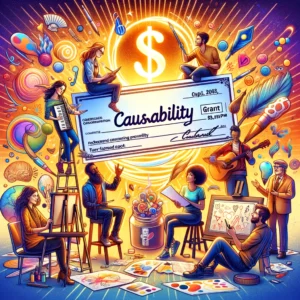In a world brimming with messages and missions, how can a nonprofit ensure that its cause doesn’t just echo in the void but reaches and resonates with its community? At Causability, we understand that the heart of a nonprofit lies in its ability to communicate its cause effectively. It’s not just about getting your message out there; it’s about making it stick. This guide provides you with strategies to do just that, along with resources to stay relevant and impactful.
Understanding Your Audience: The Foundation of Effective Communication
The cornerstone of any successful communication strategy is a deep, nuanced understanding of your audience. This understanding informs how you craft your message, the channels you use, and the tone you adopt. Here’s how to gain a comprehensive insight into your audience:
- Demographic Analysis: Start by gathering basic demographic information about your audience. This includes age, gender, location, education, and income level. Such data can be obtained through surveys, social media analytics, or research studies.
- Psychographic Profiling: Beyond demographics, understanding the psychographics – the attitudes, interests, personality, values, opinions, and lifestyle – of your audience is crucial. This information shapes the type of content that will resonate with them.
- Engagement Metrics: Analyze how your audience interacts with your current content. Which topics generate the most engagement? What formats (videos, articles, infographics) do they prefer? Tools like Google Analytics, Facebook Insights, and Twitter Analytics can provide valuable data.
- Listening and Feedback: Engagement isn’t just about pushing out content; it’s also about listening. Monitor social media conversations, conduct surveys, and encourage feedback to understand your audience’s needs and perceptions.
- Community Involvement: Sometimes, the best way to understand your audience is to be part of their community. Participate in forums, attend local events, or partner with community organizations.
Platforms like SurveyMonkey can be used to create surveys that help you gather insights about your audience.
Focusing on your audience lays an effective foundation for creating marketing material that resonates.
Crafting Your Message: Clarity, Consistency, and Connection
Once you have a clear understanding of your audience, the next step is crafting your message. This is where clarity, consistency, and connection come into play.
- Clarity: The primary goal of your message should be to communicate your cause simply and directly. Avoid jargon or technical terms that might be confusing. The clearer your message, the easier it is for people to understand and remember it.
- Consistency: Your messaging should be consistent across all channels and platforms. This consistency extends to the tone, style, and core messages. Consistency helps in building a strong, recognizable brand identity.
- Storytelling: Humans are naturally drawn to stories. They are more memorable than statistics alone. Share stories of the individuals or communities you serve, the challenges they face, and how your nonprofit is making a difference. This builds emotional connections with your audience.
- Adaptability: While consistency is key, it’s also important to adapt your message for different channels. The way you present your message on Instagram might be different from how you present it in an email newsletter (notice, we didn’t mention snail mail).
- Call to Action: Every message should have a clear call to action (CTA). What do you want your audience to do after reading your message? Whether it’s to donate, volunteer, or simply learn more, a clear CTA is crucial.
As a quick recommendation, Canva offers a range of templates that can help create visually consistent and compelling content across various platforms.
By crafting your message with clarity, consistency, and connection, you lay the foundation for effective communication that not only reaches but also resonates with your community.
Leveraging Social Media: Authentic Engagement
In today’s digital age, social media is a vital tool for nonprofits to engage with their audience. However, the key to success on these platforms is authenticity. Here’s how to achieve it:
- Understand Each Platform: Different social media platforms cater to different audiences and content styles. Instagram may be more visually focused, while Twitter is great for quick updates and engaging in public conversations. Tailor your approach to each platform.
- Engage in Real Conversations: Social media should be a two-way street. Respond to comments, participate in relevant hashtag conversations, and show appreciation for user-generated content that aligns with your cause.
- Share Behind-the-Scenes Content: Give your followers a glimpse of the day-to-day activities of your nonprofit. This could be anything from the planning of an event to the impact of their donations. Such transparency builds trust and a deeper connection.
- Monitor Trends and Adjust Accordingly: Keep an eye on trending topics and see if there’s a natural way for your nonprofit to join the conversation. This can increase visibility and show that your organization is in touch with current events.
- Regular Updates and Stories: Use features like Facebook updates or Instagram Stories to share regular, timely content. These features are viewed widely and can help keep your audience engaged.
Email Campaigns: Personalized and Purposeful
Email campaigns are a cornerstone of nonprofit communication strategies, known for their effectiveness and direct reach. Here’s how to make your email campaigns stand out:
- Segment Your Audience: Not all your subscribers are the same. Segment them based on their interests, past donations, or engagement level. This allows for more targeted and relevant messaging.
- Personalization: Use the recipient’s name and reference past interactions or donations. Personal touches can significantly increase open rates and engagement.
- Clear and Compelling Content: Keep your emails concise and focused. Use compelling subject lines to grab attention and ensure the body of the email delivers on its promise.
- Mobile Optimization: Many people read emails on their mobile devices. Ensure your emails are mobile-friendly, with responsive design and easily clickable links and CTA buttons.
- Testing and Analytics: Use A/B testing for subject lines, send times, and content formats to see what works best. Regularly check analytics to understand open rates and click-throughs.
If you are looking for suggestions, email marketing tools like Mailchimp or Constant Contact offer features for audience segmentation, A/B testing, and performance analytics.
Community Events: Building Real-World Connections
While digital communication is key, the power of face-to-face interactions in building strong community ties cannot be overlooked. Here’s how to leverage community events:
- Event Planning and Promotion: Plan events that align with your cause and appeal to your audience. Promote these events across your communication channels to ensure maximum attendance.
- Engage with Attendees: Use these events as an opportunity to engage directly with your community. Gather feedback, share stories, and show the tangible impact of their support.
- Collaborate with Local Businesses or Influencers: Partnering with local businesses or influencers can help increase the reach of your event and connect with a wider audience.
- Follow-up: After the event, send thank you emails, share highlights on social media, and provide ways for attendees to stay involved with your cause.
Event management tools like Eventbrite simplify the organization process and offer features for ticketing, RSVPs, and attendee management.
Staying Relevant: Continuous Learning and Adaptation
The nonprofit sector is ever-evolving, and staying informed and adaptable is key to remaining relevant. Here’s how to keep up:
- Educational Resources: Regularly seek out educational content – webinars, online courses, podcasts, and articles – that can help you stay informed about industry trends and best practices.
- Networking and Collaboration: Join nonprofit networks, attend conferences, or engage in online communities. These are great opportunities for learning and collaboration.
- Incorporate Technology: Stay abreast of technological advancements that could enhance your communication strategies, such as new social media tools or data analytics software.
- Feedback Loops: Implement systems to gather and analyze feedback from your community. This feedback is invaluable for making informed adjustments to your strategies.
Websites like Nonprofit Tech for Good provide a wealth of resources on the latest in nonprofit technology and digital marketing strategies.
By effectively leveraging these strategies, your nonprofit can communicate its cause more effectively, build stronger community ties, and stay relevant in an ever-changing landscape.



